Color Reproduction
* For all of our color tests, we reset the cameras to their factory default settings. They were then set to record using the highest image quality option. Color space is sRGB.We took a picture of our color chart both indoors (tungsten lighting) and outdoors (direct sunlight). Click on a thumbnail below to view the full-size image.
Tungsten WB
| Auto WB | Tungsten WB | |
| Fuji FinePix A330 | 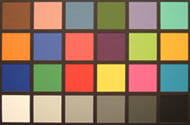 Click to enlarge. |
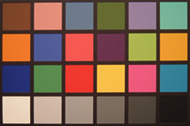 Click to enlarge. |
| Kodak CX7330 | 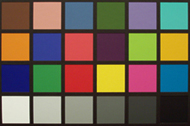 Click to enlarge. |
N/A |
| Olympus D-540 | 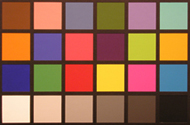 Click to enlarge. |
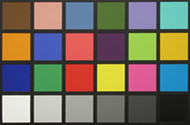 Click to enlarge. |
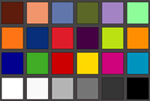 Reference Chart ("actual colors") |
||
| Auto WB | Incandescent WB | |
| Fuji FinePix A330 |  |
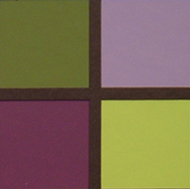 |
| Kodak CX7330 | 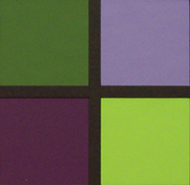 |
N/A |
| Olympus D-540 |  |
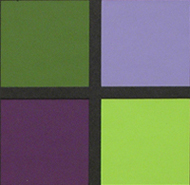 |
Under tungsten lighting with Auto white balance, the Kodak camera has the best color reproduction. The Fuji A330 shows a very slight yellow/orange cast while the Olympus was afflicted with a rather strong yellow/orange cast. When each camera was set to Tungsten WB, the Olympus camera showed very accurate color reproduction. The Fuji camera still displays a yellow/orange cast here. The Kodak camera does not offer adjustable white balance options.
Daylight WB
| Auto WB | Daylight WB | |
| Fuji FinePix A330 | 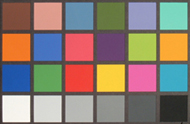 Click to enlarge. |
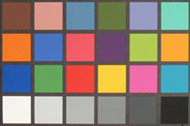 Click to enlarge. |
| Kodak CX7330 |  Click to enlarge. |
N/A |
| Olympus D-540 | 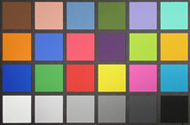 Click to enlarge. |
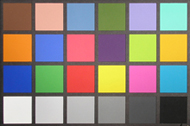 Click to enlarge. |
 Reference Chart ("actual colors") |
||
| Auto WB | Daylight WB | |
| Fuji FinePix A330 | 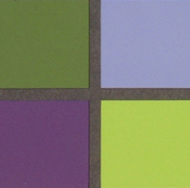 |
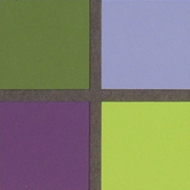 |
| Kodak CX7330 | 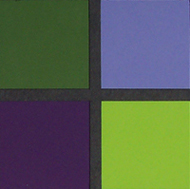 |
N/A |
| Olympus D-540 | 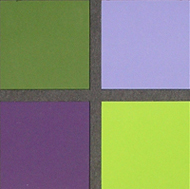 |
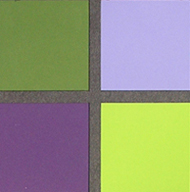 |
When set to Auto WB in the sun, all three cameras proved to be capable of very accurate color reproduction. However, this comparison also shows the differences in exposure. The Fuji camera produced the brightest colors while the Kodak camera produced the darkest. With the cameras set to Daylight white balance, both the Olympus and Fuji cameras produced very accurate colors. The only significant difference is that the Fuji chart is a bit brighter and more saturated than the Olympus. Again, the Kodak camera offers no other setting than Auto.
Studio Shot
In this shot, we tested the camera's ability to reproduce colors in our studio shot using different WB settings under tungsten light.| Auto WB | Tungsten WB | |
| Fuji FinePix A330 |  Click to enlarge. |
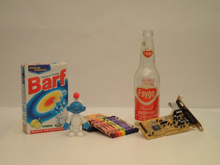 Click to enlarge. |
| Kodak CX7330 | 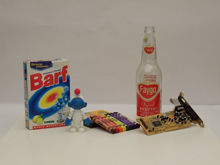 Click to enlarge. |
N/A |
| Olympus D-540 | 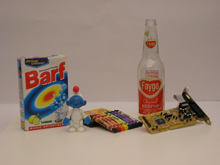 Click to enlarge. |
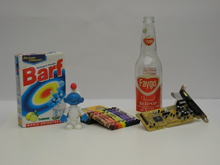 Click to enlarge. |
Not surprisingly, the Kodak camera produces the most accurate colors of the three cameras. However, it is interesting to see that the Fuji camera actually has a stronger yellow/orange cast than the Olympus camera. This is the opposite of what we saw with the color charts above. When the cameras are set to Tungsten WB, the Olympus D-540 shows a very accurate color performance and underexposes the frame, while the Fuji A330 has a yellow/orange cast and a brighter exposure than the Olympus.
Built-in Flash
For the flash test, we set the cameras to Auto mode w/Auto flash. The pictures were taken from 5 feet away.| Fuji FinePix A330 | Kodak CX7330 | Olympus D-540 |
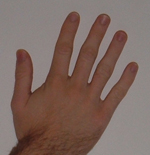 Click to enlarge. |
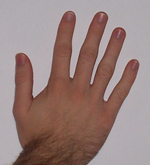 Click to enlarge. |
 Click to enlarge. |
In this flash comparison, all three cameras managed to avoid any color cast on the white background. However, it is fairly obvious that they all reproduce skin tones differently. The Olympus D-540 produces the most accurate skin tone followed by the Fuji A330. The Kodak CX7330 has oversaturated the hand producing a reddish appearance.










16 Comments
View All Comments
Jeff7181 - Friday, December 31, 2004 - link
Nice article... would have been nice to see it BEFORE the holidays though ;)stephencaston - Friday, December 31, 2004 - link
#4,Unfortunately, when it comes to digital cameras, it is impossible to cover every camera at a specific price point. We had to make choices when picking which cameras to use and ended up choosing three cameras at $150 with very similar features to make the comparisons more relevant.
I did not mean to imply that this article will determine the best camera at $150. The article was meant to compare these three cameras to each other. I have amended the title accordingly to reflect this.
We always encourage people to do as much research as possible before buying a camera. There are so many different things to consider when reviewing digital cameras and each review site focuses on different areas.
PrinceGaz - Friday, December 31, 2004 - link
I'd take the Minolta DiMAGE X31 over any of the cameras reviewed any day; it's a lot more compact than them which is what many people desire when out and about, is reported to give a good picture for it's price and size, has lots of features, and at $150 is just as cheap as them. My DiMAGE X20 is a lovely little camera that does everything you could ask of it, and from what I've read the X31 makes a good thing better.I will reiterate a point I made when digicam reviews first appeared on AT, which is that unless you can review *every* model in depth to find which is the best in that category, then you are doing a dis-service to your readers by potentially not even looking at what might be the best camera in that range.
Specialist digicam websites review all cameras so that they can give an informed opinion on any new models, even if that means buying one themselves like AT might do for a computer product that free review samples weren't available for. What AT is doing with digicam reviews is just picking two or three models out of the many available and saying one of them is the best, when better ones you didn't even look at are available. AT does excellent reviews of computer components, but I'm afraid you'd have to be a fool to only use your recommendations when buying a digicam.
orenb - Friday, December 31, 2004 - link
The best digital camera at this price point is the Ricoh Caplio RX. 28-100mm zoom. Metal body. Almost no shutter lag. These three don't even come close.Prog.
Joony - Friday, December 31, 2004 - link
The Canon A400 should be in this review...cosmotic - Thursday, December 30, 2004 - link
Again, Kodak EasyShare is turned into an ad link and blends into the background of the table cell.